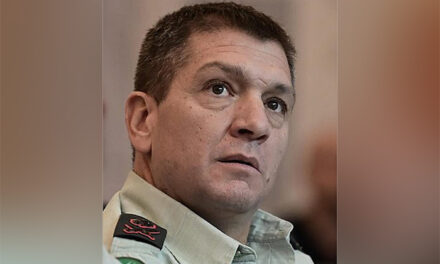Empty seats at Sinai Temple in Los Angeles labeled to remember the hostages still being held captive by Hamas in the Gaza Strip since Oct. 7, 2023. Courtesy Photo
For the past year, Rona Passman has thought continuously about someone she cannot see—her uncle Amiram Cooper, whom Hamas terrorists kidnapped from his home in Kibbutz Nir Oz along the border with the Gaza Strip on Oct. 7.
“If I ate, I would remember that he was being starved. If I took a shower or brushed my teeth, I knew he was sitting in utter filth lacking any basic hygiene,” the Los Angeles real estate agent told JNS. “Even just cleaning my glasses, I would remember that Hamas broke his glasses, and he couldn’t see anything the entire time,” Passman added.
Sinai Temple, the Conservative synagogue that Passman attends in Los Angeles, dedicated 240 of the 1,000 seats in its sanctuary to the hostages the week after Oct. 7. That included one for Cooper, 85, an economist, poet and composer, who was a founding member of Nir Oz. (The Israeli military informed Cooper’s family in June that he was murdered and that Hamas is holding his body.)
Passman told JNS that she is grateful that her synagogue made the effort to share her experience.
“I think it is important to talk about Amiram—to show that he is a real person with a family that loves him,” she said. “He is not just another poster.”
Jews have long created symbolic physical presences for those who are unseen, from the Elijah cup during the Passover seder and the Elijah chair at circumcisions to the ushpizin prayer, in which forefathers and foremothers are invited into the sukkah during the holiday. Some Jews leave portions of the ceiling unpainted to remember the destroyed Temple in Jerusalem—the same idea many be memorialized when we break glass during Jewish weddings.
“It is an essential part of the Jewish tradition to dwell among ghosts,” David Wolpe, rabbi emeritus of Sinai Temple in Los Angeles and scholar-in-residence at the Maimonides Fund, told JNS.
“Our community is much larger than the people in front of us, and so our tradition is trying to make us aware of that, both horizontally around the world and vertically through time,” said Wolpe, who stepped down from Harvard University’s Jew-hatred task force last year. “It’s particularly intense when a member of the community is in trouble.”
Setting empty chairs for the hostages on Shabbat or at the seder table hearkens back not only to Jewish religious traditions but also to efforts to draw attention to the plight of Soviet Jewish prisoners in the 1970s and 1980s, according to Wolpe.
As the High Holidays approach, Hamas continues to hold 101 hostages, including 97 of the 251 captured on Oct. 7. It is not known publicly how many hostages are living, making it more difficult than ever to conjure their presence.
Subdued Commemoration
The sort of “absent presence” evoked by empty seats designated for hostages in a synagogue or place settings at a holiday table is inherently paradoxical—perhaps doubly so when those seeking the release of the hostages have never met them.
“When a loved one is an absent presence because they are missing in action, then there is very little after a certain point that anyone can do,” Ilana Blumberg, professor of English at Bar-Ilan University in Ramat-Gan whose teaching areas include trauma and literacy, told JNS.
“What is exceedingly painful these days is that the citizens taken hostage are not lost,” Blumberg said. “They aren’t necessarily dead. They are presences, elsewhere. Suffering.”
In Bridgeport, Conn., Congregation B’nai Israel set up an empty seder table for the hostages in its lobby on Passover. But after Israel said in late August that it had recovered and identified the bodies of six hostages, including that of 23-year-old Israeli-American Hersh Goldberg-Polin, the Reform synagogue has more subdued plans for the High Holidays.
B’nai Israel’s library will become a “meditation room,” stocked with information about the hostages, to which congregants can retreat during services, according to senior Rabbi Evan Schultz. The congregation plans to expand Yizkor—the prayer recited for deceased close relatives—to include those lost on Oct. 7 and in the year thereafter.
For some congregations, efforts to remember the hostages have had diminishing returns.
“I don’t think it has a constant effect. People get used to things. I’m being honest,” Bracha Jaffe, associate rabba at the Hebrew Institute of Riverdale-The Bayit, told JNS. (A Modern Orthodox congregation in Riverdale, N.Y., the synagogue has a senior rabbi, Steven Exler, and associate and part-time rabbas, who are women.)
Hebrew Institute of Riverdale dedicates seats in its sanctuary and a table at its communal Shabbat and holiday meals to the hostages held in Gaza.
“Does it radically change the meal? No. Does it make us talk about the hostages? No,” Jaffe said. “Yet it’s become very important to us.”
Profound Absence
In Connecticut, members of the Fairfield Jewish Advocacy Coalition gather every Sunday for a walk and run in the town center during which participants carry photographs of the hostages.
Beth Segaloff, a co-founder of the group and a member of Congregation B’nai Israel in Bridgeport, Conn., told JNS that one of the photographs is always of Almog Sarusi, the 27-year-old man who was abducted from the Nova music festival near the Gaza border on Oct. 7.
The group opted to feature Sarusi because he was the neighbor of a Fairfield resident who moved to Israel several years ago. Although his was one of the bodies that Israel identified and recovered late last month, those who walk and run continue to bear his image.
“Their absence is so profound,” Segaloff told JNS of the hostages. “I feel very scared and very hopeless, and I also feel the love and the connection with others in our circle each week.”
“I’m not going to give up,” she added.
That profound absence compares and contrasts with other “present absences” in Jewish practice.
Blumberg, the Bar-Ilan professor, told JNS that there is a fundamental difference between chairs left empty for hostages and, for example, the chair left for the prophet Elijah at circumcisions, which she said refers to a metaphysical being. “We believe in presences that are not visible—that are collectively called upon, that serve functions for us,” she said.
Empty spaces left for hostages are a reminder that something is wrong, according to Blumberg.
“We are saying, ‘There is absence where there should be presence, and we refuse to normalize or forget that the absence is an offense, unacceptable,’” she said. “We are waiting for the absence to turn to presence, and we believe it will.”
“It’s an act of faith and also of protest, which is what makes it so powerful,” she added. “It negates the immediate reality and also transcends it, and it sets the imagination toward return.”
Setting aside seats in synagogue sanctuaries, which tend to be packed during the High Holidays, presents logistical problems.
At Sinai Temple in Los Angeles, posters with the faces of the hostages will replace the reserved empty seats, and the congregation commissioned two Torah covers memorializing the victims of the Oct. 7 attack. It will dedicate the latter on Simchat Torah—the anniversary on the Jewish calendar of the massacre. One will bear Amiram Cooper’s name.
When Passman saw the news that her uncle had been killed in Gaza, it gave her no closure, she told JNS.“Everything changed to wondering what his last moments were like,” she said. “Did he think we gave up and abandoned him?”
She said she appreciates the attention that her uncle has received. His poetry has been republished, and his musical compositions have been performed. But even if conjured in memorials, the fact remains that his body is in Gaza, along with other hostages.









